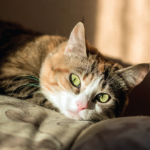Autoimmune diseases are frustrating. In an autoimmune illness, the protective immune cells in your cat’s body turn hostile and attack the body. Diagnosing and treating autoimmune illnesses is rarely easy, especially with skin diseases.
The most common skin-related autoimmune disease in cats is pemphigus foliaceous. In pemphigus foliaceous, the normally protective antibodies attack the proteins that hold the skin cells together.
Cats with pemphigus generally have a variety of skin lesions, mainly pustules often covered with crusty debris. Pus accumulates in the spaces left behind when the antibodies destroy the proteins holding the cells together. Inflammation follows, with potential secondary bacterial infections. Lesions are often found in bilaterally symmetrical patterns.
Many affected cats are pruritic (itchy), although others act more like their skin is painful. Areas usually affected include the head (eyes, ears, chin, lips, and nose), paws (nail beds and paw pads), and nipples. Left untreated, other areas of the body may eventually show damage as well.
Some cats will have a fever with a corresponding lethargy and decreased appetite. Lymph nodes may be enlarged. Any age cat may develop pemphigus, but most are middle age to seniors.
Causes
Why immune cells go rogue is unknown, although reactions to medications, some toxins, and severe allergic reactions are suspected culprits. Reactions to medications, however, are often not true autoimmune problems. Once the medication is stopped and all metabolites are gone from the body, the cat’s skin returns to normal on its own. Other cats can have immunosuppressive medication gradually weaned off and do not relapse unless exposed to the offending medication again.
Stress certainly lowers a cat’s resistance to immune problems, but it’s not clear if it’s a direct trigger for pemphigus. In a few cases, littermates have been affected, which suggests an underlying genetic defect or predisposition.
Despite frequent blame, vaccinations have not been associated with this autoimmune skin problem. In addition, cats with the two feline viruses commonly connected to immune problems (feline leukemia virus and feline immunodeficiency virus) are not at higher risk of developing pemphigus.
What Is Immunity?
Basic immunity, the body’s natural ability to fend off infection, is based on two mechanisms: 1) antibodies, which are proteins produced to fight specific threats, and 2) lymphocytes, which are immune cells that attack and kill invading cells. In autoimmune diseases, these cells attack healthy normal cells instead of foreign, invading organisms and are called “autoantibodies.”
Diagnosis
A biopsy is required to arrive at a definitive diagnosis of pemphigus. “It is very common to treat any skin disease in the cat with steroids. The dosages used to treat the allergic cat will do little or nothing for the cat with pemphigus except slow down the diagnostic effort. The diagnosis of any autoimmune skin disease is based on skin biopsy results. Steroids will alter the inflammatory changes in the skin and may make it impossible to diagnose the condition. If the cat has a very unusual skin disease and the owners have the resources, following the ‘Let’s try steroids and see what happens’ protocol isn’t the way to go. Do the diagnostics first, because the cat will have to be treated with potentially dangerous drug protocols for the rest of its life,” says William H. Miller Jr. VMD DACVD, professor emeritus of medicine, section of dermatology, at Cornell University’s College of Veterinary Medicine.
Typical of many autoimmune problems, pemphigus can be treated and put into remission but is never really cured. Some cats will have a cyclical nature to their skin lesions, which may make it tempting to stop treatment. However, many cats will relapse, especially when treatment is stopped or tapered to a low level. Once off the medication, or on a lower dose, if the cat is exposed to its triggers again, the disease will often reappear. Many, if not most, affected cats need to be on some type of immunosuppressive medication for life once the disease has appeared.
The first line of therapy for cats with pemphigus foliaceous is usually prednisolone. This is inexpensive and cats are more resistant to glucocorticoid side effects than dogs are. This may be combined with immunosuppressive medications such as chlorambucil and cyclosporine. These drugs tend to have more serious side effects, however. A study published in Veterinary Dermatology (ncbi.nlm.nih.gov/pubmed/24118463) found that cats treated with a simple low dose of prednisolone did as well as cats with the more expensive combined treatment. Many cats relapsed once the dose was lowered dramatically, although some cats maintained their skin health on weekly doses. Topical steroids are rarely successful.
Cats with nail-fold lesions are often put on antibiotics based on cytology showing bacteria in the exudate from around the claws. However, in this same study, once problems resolved with the immunosuppressive medications, no antibiotics were needed.
“The big issue with treating cats for any autoimmune disease is the size of the drug doses (i.e., pills) available, since cats are small and require small doses. Luckily, steroids are inexpensive and come in cat-friendly sizes. The other immunosuppressive drugs, used regularly in dogs, are expensive (e.g., cyclosporine) or only come in dosage sizes too large for the cat (e.g., mycophenolate). Steroids typically are the initial drug of choice in most cats because they are inexpensive, usually work very well and cats are more resistant to, but not immune from, steroid side effects,” says Dr. Miller.
Bottom Line
Since true pemphigus rarely goes into spontaneous remission, most cats will need steroids for the rest of their lives and will eventually show side effects. Resolution of clinical signs or disease control often takes a couple of weeks. Cats on long-term glucocorticoids such as prednisolone should have periodic blood monitoring to watch for side effects such as anemia and diabetes. Fairly benign side effects are polyuria and polydipsia (urinating and drinking more than usual).
Avoid the impulse to bathe your cat. The skin of a cat with pemphigus is fragile, and standard bathing with cat shampoo will likely make things worse. When the lesions start to crust up while healing is occurring, a gentle soaking to help remove the crusts might be beneficial. However, stress can weaken the immune response of the cat and even a gentle soaking might make things worse if the cat isn’t a big fan of baths. Minimizing stress is always recommended.
Oral Gingivostomatitis
It may surprise you to learn that chronic gingivostomatitis complex (a severe, chronic form of gum disease) is an autoimmune disease. In gingivostomatitis, the antibodies attack the mouth, specifically around the teeth. While immunosuppressive medications, laser, and stem-cell therapy have all shown potential success in treating this condition, removing all the teeth remains the gold standard for therapy. This sounds drastic, but it gives cats a pain-free mouth, and they are still able to eat, drink, and play without teeth.
Gingivostomatitis is a debilitating feline dental disease marked by severe and chronic inflammation of a cat’s gingiva (gums) and mucosa, the moist tissue that lines its oral cavity. Although the condition is most frequently diagnosed among cats with certain viral diseases, as well as bacterial infections and various nutritional and hormonal conditions, no direct causal relationship between such disorders and gingivostomatitis has as yet been established. Any or all of these conditions, however, can cause an abnormal immune response to plaque, the thin coating of bacteria that normally accumulates on the surface of teeth.
According to Jennifer Rawlinson, DVM, chief of the dentistry and oral surgery section at Cornell University’s College of Veterinary Medicine, “The immune system becomes overly reactive to plaque and causes severe inflammation in the gingiva, initially around an affected tooth and then quickly progressing to the tissue in the surrounding area.”

Additional Skin Lesions to Be Aware Of
Pemphigus vulgaris and pemphigus erythematosus are rare but can occur in cats. Vulgaris occurs primarily at mucocutaneous junctions such as the mouth and anus, while erythematosus usually affects the nose and may be influenced by ultraviolet light exposure.
Bullous pemphigoid shows up as fragile vesicles (fluid-filled blisters), mostly at mucocutaneous junctions but also in the groin and armpits. It is difficult to find the vesicles as they are thin-walled and break easily. Cats with bullous pemphigoid are itchy. Owners might notice hives or welts and severe pruritus before any vesicles are noted. Luckily, this illness may spontaneously resolve. Otherwise, the same immunosuppressive drugs for pemphigus foliaceous are used for treatment.
Lupus erythematosus (commonly called lupus) can be seen in cats in both the systemic and discoid or cutaneous forms, although both are rare. The antinuclear antibody blood test (ANA) used for diagnosis in dogs and humans is not standardized for cats. Dr. William Miller says cats with the systemic form of lupus have multiple organs, such as the kidneys, involved as well as the skin. Lameness may be noticed by astute owners. Skin lesions tend to resemble pemphigus foliaceous. The prognosis is poor. Cats with the discoid form may lose pigment around their lips and eyes. The texture of their nasal skin may also change from the normal “rough” appearance to very smooth. Luckily, this form is fairly benign.



